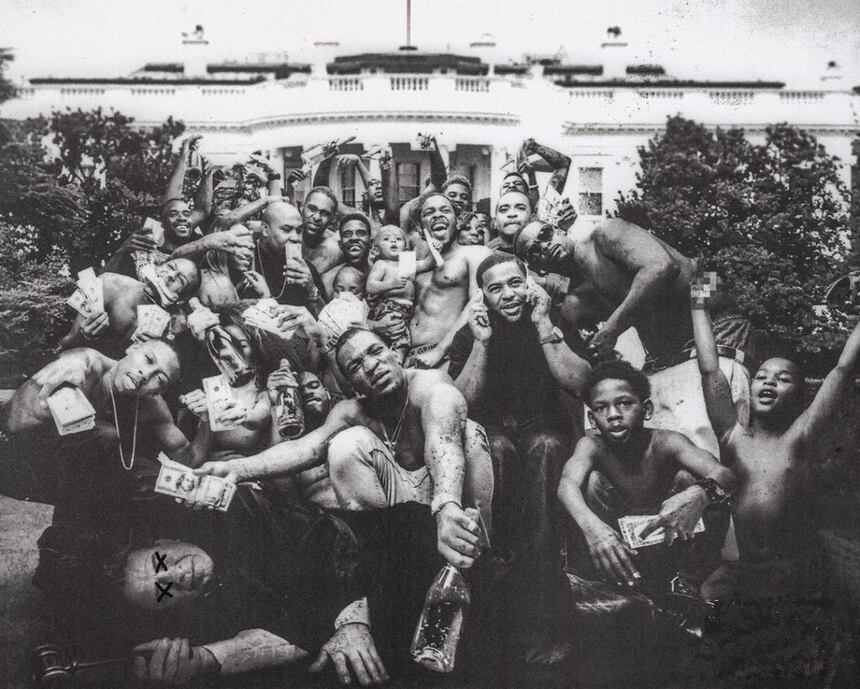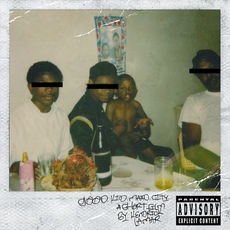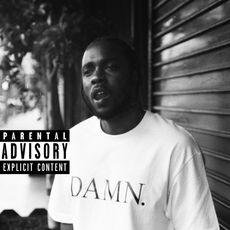The five minutes and fifty seconds went by almost unnoticed. And yet, everything was already there. In July 2011, on Ab-Souls Outro, second to last track of his first album Section.80, Kendrick Lamar proved that he wasn’t just another rapper. At 24 and after five mixtapes that spread extensively among insiders, the young MC born in Compton, in the south of Los Angeles, let his flow dip into an improvisation that was more jazz than rap, carried by the saxophone of producer and multi-instrumentalist Terrace Martin. And even if the rest of the disc is already of a certain caliber, this improbable digression looking toward old style jam sessions shows a rapper going against the flow of the competition that is obsessed with trap music, money and ego-trip galore. Still on this first album, you’ll hear on HiiiPower the names of Martin Luther King and Malcolm X resonate, two icons frequently cited by golden age rappers such as Public Enemy, 2Pac, Nas and a few hundred others. It’s enough to make of Kendrick Lamar the ambassador of a return to a conscious rap, unfortunately now almost invisible in the US despite the situation being quite dark for the African-American community…
For all that, Kendrick Lamar’s rap is no taxidermy, nor retrograde or not dated, and it is indeed rap from the 2010s (even if his first name is an homage to Eddie Kendricks, formerly from the Temptations that his mother loved so much). In an era when everything is blended and shared, he blends and shares. His starting point may be his native California, but his point of arrival is global. This California where he was born on June 17, 1987 is one of the finest hours of West Coast rap, preferably gangsta, with its names engraved on the pediment of the pantheon: N.W.A. and its straight flush (Dr. Dre, Eazy-E, Ice Cube, MC Ren and DJ Yella), Snoop Dogg and Tupac. Incidentally, it’s on the filming of the clip of Tupac’s and Dre’s California Love that a 9 year-old Kendrick is brought along by his dad, a former member of the Gangster Disciples, a gang from South Chicago that he flew from, toward Compton in fact. Despite this environment in which the conflict between Crips and Bloods rage, Kendrick will remain top of the class, or rather an incredibly astute observer, as evidenced by Good Kid, M.A.A.D City, his autobiographical masterwork from October 2012, one of the most beautiful autopsies of gangsta rap whose sound he grew up listening to, as he stands there, in the middle of Compton, surrounded by big shots, little hoodlums and cops on their toes. It’s the look of a boy where above him bullets fly and who already understands everything without lecturing his peers. Education, poverty, segregation, drugs, alcohol, the relationship between men and women, religion, each and every theme is sifted through honed rhymes balanced on a barely nasal flow, almost old school, and productions where you will find samples from Grant Green, Al Green, Bill Withers, Janet Jackson, the Five Stairsteps, Beach House and the Ohio Players…
Kendrick Lamar - Poetic Justice (Live on SNL)
KendrickLamarVEVOWith this second album, Kendrick Lamar proves he’s a master of narration, brushing clichés off with the back of his hand and imposing the flexibility of a voice influenced by many elders (in his interviews, he cites Mos Def, Snoop, The Game, DMX, Eminem, Tupac, Dre, prodigy of Mobb Deep, Notorious B.I.G., Eazy-Z and Rakim). Even better, he already manages to appeal to every audience. His virtuosity moves the hip hop experts, his prose level speaks to novices, and his sense of melody doesn’t alienate the mainstream audience, quite the contrary in fact. He becomes THE phenomenon of the genre that everyone wants to work with. During the same year of 2012, the Californian will record more than thirty featuring tracks (Dido, ASAP Rocky, Talib Kweli, Jay Rock, Schoolboy Q, The Game, Mac Miller, E-40, DJ Khaled, Skeme, Big Sean…) and just as many the following year (Miguel, Solange, J. Cole, Robin Thicke, 50 Cent, ASAP Rocky, Young Jeezy, Kid Cudi, Mayer Hawthorne, Eminem, Emeli Sandé…). However, no one can imagines what will follow…
Because in 2015, well aware that people are waiting to see him fail, Kendrick Lamar records an album fraught with danger that will take the opposing view of Good Kid, M.A.A.D City. This third album, To Pimp A Butterfly (and his title being a nod to Harper Lee’s famous novel from 1960, To Kill A Mockingbird), only comforts his place on the throne. It’s an opus that doesn’t try to rub the audience the right way, and displays impressive density both in style and content, in its productions as in its texts. Far from taking the easy route by surfing on the success of Good Kid, M.A.A.D City, the MC from Compton blends here a multitude of styles, sometimes even daring. G-funk, jazz, boom bap, nu soul, electro, Blaxploitation, funk, P-Funk, Dirty South, nothing is missing! Kendrick’s soul train looks as much in the rear-view mirror of the Great Black Music as right in front of him. As for his writing, its agility is also frightening. Introspective trip, social commentary, irony, political digression, witticism, urban prose or ego trip, he knows and can do everything! And with Alright, he even pens some kind of hymn to Black Lives Matter, this militant movement against violence perpetuated toward Blacks which was born two years earlier…

The density, both musical than verbal, of this Afrocentric third album proves that Kendrick is there for his art and his community, and not just to boost his bank account thanks to an audience already more than won over to his cause. As for featuring tracks, there is some regional with the Snoop Dogg stopover, but also some Flying Lotus, Pete Rock, Pharrell Williams, Ronald Isley from Isley Brothers, Bilal, rapper Rapsody or singer SZA. Above all, many “real” musicians, coming from the jazz scene for most of them, also taking an active part in the recording. Members from the collective West Coast Get Down like saxophonist Kamasi Thundercat, but also trumpet player Ambrose Akinmusire and pianist Robert Glasper make their contribution to this impressive album, highlighting at the same time the porosity between the jazz and Californian rap scenes… One cannot help wonder if with this album, whose cover displays Compton youths posing in from of the White House with their hands full of wads of dollars banknotes (the picture is the work of Frenchman Denis Rouvre), Kendrick hasn’t indeed provided to the 2010s what Nas had provided to the 90s with his mythic Illmatic. In an interview with magazine Rolling Stone in 2017, he declared that this disc “is me talking to my homeboys with the knowledge and the wisdom that I gained.”
Kendrick Lamar - HUMBLE.
KendrickLamarVEVOHowever, Kendrick Lamar doesn’t want to cut himself off from the mainstream audience and only remain the favorite of authorized circles, or even of a certain intelligentsia. In order to do so, he appears on Bad Blood, the single of Taylor Swift, the new queen of pop, and on Beyoncé’s Freedom. He signs a lucrative deal with the Reebok brand to endorse the Ventilator model. During the spring of 2015, the California State Senate bestows him with the Generational Icon Award for his multiple acts of promotion for his native Compton. The following year, the mayor will even symbolically give him the keys to the city! Finally, in 2016, he meets Barack Obama for My Brother's Keeper Challenge, the highly publicized sponsorship program that partners young men of colors with civil right leaders and artists which was created by the American president. No doubt here, the artist, spokesperson, activist, star and entertainer is one of a kind! A unique Kendrick, on stage like in real life, on earth like in the skies, that is precisely what offers DAMN.. “The initial goal was to make a hybrid of my first two commercial albums”, he repeated when releasing in April 2017 this fourth album, both smart and somewhat conceptual, but also a lot more accessible than To Pimp A Butterfly.
Here, the hit rubs shoulders with the more avant-gardist, the sensual mixes with the more hardcore, the effluvium of 70s psychedelic soul (Lust) get jiggy with electro minimalism (Humble). His engaged writing remains as sharp as ever, between preaches and more personal introspections, punctuated of nice allegories of Trump’s America. Thus, when Fox News’ presenter Geraldo Rivera claims that “hip hop has done more damage to young African-Americans than racism”, Kendrick brilliantly answers him on DNA, a complete analysis of his personal DNA. Further, on Duckworth, he becomes the narrator of the former hardships of his father, the former member of a chicagoan gang. From the highest to the lowest common denominator, Kendrick Lamar raps here in every direction. The guest list to this party is also as eclectic as possible: Rihanna (Loyalty), U2 (XXX), James Blake (Element), Kaytranada (Lust), Kamasi Washington (Lust), Steve Lacy from The Internet (Pride), Thundercat (Feel), the Canadians from BadBadNotGood (Lust), not forgetting Kid Capri (Element, XXX, Duckworth et Love)—a cult DJ and MC from the Bronx who officiated at the dawn of the 90s, in the middle of the golden age of rap. Each and every one of them brings not only their personal touch but also displays, over and over again, the open-mindedness and the thirst of an artist going beyond the boundaries of hip hop. Once again, we are stunned when finishing this ultra-powerful disc which polishes a bit more the crown of its author. Able to reinvent himself, Kendrick Lamar can take advantage of the situation to take the time to support a few protégés (SZA, Lance Skiiiwalker, Zacari Pacaldo, SOB x RBE, Babes Wodumo…) while waiting for a solid succession to eject him from his pedestal. But for now, the horizon is clearer than ever…
Translated by Damien Izabelle.









